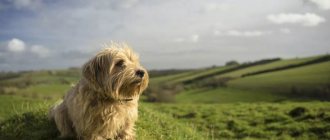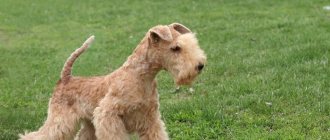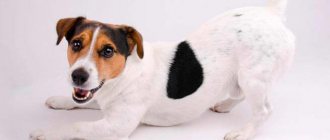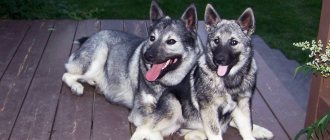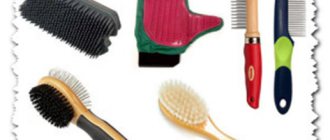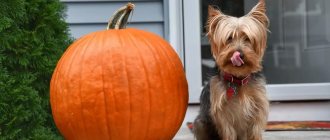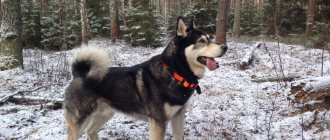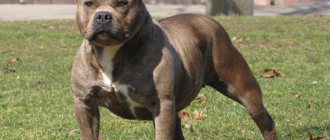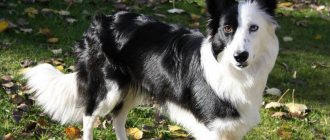Breed dossier
Country of origin: Germany
Classification:
Group 6: Hounds and related breeds
Section 1: Hounds
Subsection: 1.3 Small
Training: Easily trainable.
Color: Dogs vary in color from red to yellow with a black saddle or mantle. There are white markings: a white spot or star on the forehead, a white muzzle with a “collar”, white chest, paws and the tip of the tail. A white stripe runs along the back of the nose.
Dimensions: Height at the withers - 30-38 cm, weight - 16-18 kg.
General impression: A dog of medium height, unpretentious, hardy, with good instincts and innate malice towards the beast.
Usage:
The Dachshund Bracket is a dog adapted to the difficult conditions of mountain hunting grounds, which chases the animal calmly and slowly, with a voice.
Today, the Dachshund Bracket is used for flushing game, mainly when hunting hares, foxes, rabbits and ungulates. In addition, she is good at fetching game birds. The hounds pursue the animal with loud barks and at a distance long enough for the hunter to confidently shoot it.
Dogs are capable of hunting in deep snow.
Thanks to its good scent and constant readiness to work on the scent, the Westphalian Bracket copes well with the duties of a blood hound. To work on a blood trail, it is used on a leash.
Physical activity: Needs fairly long walks with moderate physical activity.
Personality: Cheerful and friendly.
Contents: The dog is perfect for keeping in the city.
Grooming: Grooming is minimal.
Liveability:
She is very friendly and coexists with other pets without problems. Also, the Westphalian Dachshund can be left with children without any problems.
Diseases: One of the diseases found in this breed is urolithiasis.
Diet: It is advisable to consult a specialist regarding the diet for this breed.
Life expectancy: about 13 years.
How to choose a dog
Westies are becoming more and more popular and unscrupulous people are profiting from the sale of pseudo-pedigreed puppies.
Therefore, never buy a dog at the market.
Even if you are lucky and the purchased puppy turns out to be healthy, it will not necessarily grow up to be a West Highland dog and not an ordinary white mongrel.
Contact well-known nurseries with a good reputation that have been working with the breed for several years.
In this case, you will be able to receive all possible assistance in raising and raising a puppy, see the baby’s parents and make sure that the West Highland White Terrier puppies were raised in good conditions.
Choosing a puppy is a very responsible matter.
Experienced dog breeders recommend choosing not the largest puppy from the litter, but the most nimble, active and inquisitive one.
Carefully examine the baby: he should have clear eyes, without any discharge, a clean, moist nose, clean and pink ears.
The belly should not be bloated and there should be no signs of loose stool under the tail.
History of origin of the breed
Speaking about breeding dachshund hound breeds, it should be noted that German dog breeders have achieved the most successful combination of two different types of hunting dogs: the strength and stability of the dachshund with the speed and quickness of the higher-legged dachshund hounds.
It is impossible to say definitely when this breed began, one thing is obvious: it has existed for several centuries.
In its homeland in Germany, the Westphalian dachshund successfully hunts hare, fox, wild boar and rabbit.
Maintenance and care
You can safely own a Lakeland Terrier both in urban and rural areas. You just have to remember that the dog should under no circumstances be exposed to hypothermia. Therefore, create conditions for your pet so that its place is warm.
In addition, the Lakeland Terrier breed is a hunting breed and needs constant physical activity. In an urban atmosphere, find a large square or park, preferably with a pond, to take your dog for daily walks.
The Lakeland Terrier's coat does not require any complex care. The dog should be trimmed once a quarter. You can brush your pet once a week to remove excess hair. The Lakeland Terrier is practically non-shedding, so you don’t have to worry about a lot of fur in your home.
Pay attention to the dog's ears and eyes, keep them clean. Claws also require regular adjustments.
Video
Character and temperament
The breed, despite its not too large size, has incredible courage, courage and fearlessness. The Lakeland Terrier is an excellent hunter. He can easily drive a wild animal into a hole and rush at it. In addition, the dog has an extremely sensitive nose, which allows it to accurately pick up the scent of an animal and lead the owner to it. In the family circle, the dog is kind, affectionate and reliable. Distrustful of strangers, so can be a vigilant watchman.
See also: Golden Retriever
Nutrition
The dog's diet should be balanced. That is, along with food, the dog should receive carbohydrates, proteins and fats, vitamins and microelements. Therefore, you can give your dog meat, cottage cheese and fish. Eggs will also be useful for your pet. The meat offered to the dog should not be fatty. It could be turkey, rabbit or beef. You can add milk to your Lakeland Terrier’s diet, preferably along with porridge or bread. Porridge is always cooked in water, milk is added at the very end of cooking. The animal will benefit from fruits, vegetables and herbs, which are the main sources of vitamins. Food is served in crushed form.
A little bit of history
This breed is one of the most ancient among all terriers. The first mentions appeared back in 1800. True, at that time the dog had a slightly different name, but after crossing the English Wirehaired Terrier with the Bedlington Terrier, the Lakeland was obtained.
The breed appeared in England for hunting foxes, badgers, etc. The dog could catch up with prey on uneven terrain, in a forest or field, as well as near water. The first exhibition was in 1912, it was then that the first breed standard was adopted. The latest changes to the Lakeland Terrier standard were made in 2009. As noted above, today a dog of this breed is practically not used for hunting; it acts as a companion and participates in exhibitions.
a brief description of
- Other names: Lakeland terrier, Patterdale terrier, Lake District terrier, leechka;
- Height: up to 38.0 cm;
- Weight: no more than 8.00 kg;
- Color: red, gray and tan, black, blue, liver, wheaten;
- Coat: long, hard to the touch, wire-like with a short, soft undercoat that lies close to the body;
- Life expectancy: up to 16 years;
- Advantages of the breed: Possesses all the qualities of a true terrier - courage and determination, fearlessness and determination. In games, the dog is dexterous and gambling. It shows the highest degree of friendliness towards humans and is always ready to follow its owner wherever he goes.
- Difficulties: Dogs tend to provoke fights, and males especially suffer from this quality. They also bark a lot and love to dig.
- Price: $1250.
Diseases
The Lakeland Terrier has a lifespan of 12-16 years and has minor health problems. The breed may suffer due to:
- lens luxation;
- prognathism;
- hypothyroidism;
- distichiasis;
- Legg-Perthes disease;
- von Willebrand's disease.
The Lakeland Terrier should also undergo regular eye examinations.
Welsh Terrier - price and how to buy correctly
Welsh Terriers are quite popular in the CIS countries, so there should not be any special problems with purchasing puppies. The main difficulty is the purebred of the dog, since there are many kennels that sell dogs with false documents or no documents at all. Such dogs cannot participate in exhibitions, and they may also have congenital genetic diseases.
When choosing a Welsh Terrier puppy, pay attention to the following qualities:
The head should be flat from the back of the head to the tip of the nose, and the cheeks should also be flat. The shape of the head is massive and blunt. In general, the structure of the head is shaped like a brick. The wool is rough to the touch, but pleasant. There should be no spots in the color. Welsh Terrier puppies are born completely black.
Pay special attention to these points. The puppy can be weaned from its mother at the age of one month. With the pedigree, the owner receives a card containing all the necessary data to establish the puppy’s breed: pedigree of the parents, address of the breeder, dog’s name and anthropometry
The cost of Welsh Terrier puppies varies. Usually they can be purchased at a nursery for about 10 thousand rubles, although the maximum cost reaches 35 thousand.
By purchasing a Welsh Terrier, you get an always active and cheerful dog. They are ready to follow their owners, accompanying the path with a ringing bark. With proper upbringing, the Welsh Terrier grows up to be a brave hunter, rat catcher and ringing guard. They are endlessly devoted to their family and love to actively spend time with them.
The standard often describes some aspects of the dog in sufficient detail, while others are mentioned only in passing. Therefore, in order to understand what exactly determines the typicality of a given breed, descriptions are often not enough. Today we introduce Audrey Dallison, an experienced terrier specialist, who gives a brief description of the most characteristic traits found in this group of dogs. Dallison is known throughout the world as an expert, breeder and participant in many prestigious exhibitions. The text is accompanied by drawings by Cesar Alonso, also a famous terrier and judge of this group
Airedale
is the king among terriers, and this is how he should behave. “Naked” Airedales make a bad impression, but too much wool is also not good. The coat should be close-fitting, dense and harsh. The Airedale should stand firmly on its feet, as if it were about to enter the ring the next moment.
The build is quite dense, with well-developed ribs, but the dog does not look heavy. Special requirements have always been placed on the head and the “purity” of the lines of the skull. This breed has a double coat - a guard and an undercoat, which is softer and shorter. With excessive trimming, the Airedale becomes “stripped” or the undercoat becomes too noticeable.
Cairn Terrier
. These terriers are not easy to judge. The Cairn Terrier's back should not be short (as many people believe) and should maintain a natural posture. The Cairn Terrier does not need trimming. His coat should be neither too lush nor too tight. The coat should protect the dog from any weather disasters; small “hidden” ears only contribute to this. Too large eyes (which is often observed today) spoil the typical appearance of the “core”. The front paws are larger than the hind paws. It is desirable that the ends of the hairs be dark in color.
Smooth Fox Terrier
. The biggest problem in the breed today is the shape of the head. Often it lacks sculpture, and without this the head seems rustic. The eyes should be small and cheerful. Ears are small and correctly set. The neck is long, with a beautiful outlet. In addition, “cat” paws and a short back with a developed chest are required. When standing, the dog should have a good readability of the angles of the joints of the hind limbs, and this is precisely what is often lacking lately. The movements must be correct. Unfortunately, modern dogs' hind limbs do not always work well enough. Wire Fox Terriers have somewhat fewer problems in this regard. Many Smooth Fox Terriers have short necks, which is very detrimental to the overall harmony of their build. In addition, a purebred Fox is characterized by a neck with a beautiful curve, only then does the appearance acquire a characteristic typicality.
Wire Fox Terrier
. In general, this breed is similar in appearance to the previous one, with the exception of the quality of the coat, which should be hard, thick, with a short soft undercoat. Currently, there are many large dogs whose height is noticeably higher than the standard one. Excessively abundant hair on the lower body does not look very good, as it gives the impression that the dog has a very drooping chest. For this breed, the shape of the head and the expression of the muzzle are very important. The look should be as if the dog is looking for something. The breed is considered to have a long head, a well arched neck, a short back, and well-defined angulations of the hind legs, which allows for a correct topline.
Irish Terrier
Another difficult breed to examine. First of all, this terrier must give the impression of being a good runner. The ears are set high and there is a lively expression on the muzzle. The structure of the neck and body is characteristic of terriers, the ribs are rather deep than wide. The dog should not look rough.
A good coat is quite rare among the Irish, unlike other wire-haired terriers. This is one of the most beautiful terrier breeds, but nowadays there are few “Irish” breeds that live up to this concept. The Irish Terrier must stand on its toes at all times in a position of constant readiness for action. The character is friendly, except when a rival appears. The color is red, of any shade, but without dark saddle. All other things being equal, the structure of the coat is more important than the shade in the color.
Kerry Blue Terrier
. For this breed, the color and structure of the coat are fundamental. Many people do not understand that the Kerry's coat should be soft and curly, but in no case coarse. The color becomes blue by 18 months, although some blackening is acceptable. In terms of size, the Kerry Blue Terrier is larger-boned than other terriers (with the exception of the Scottish Terrier). The back is short, the chest is deep. The Kerry Blue Terrier should give the impression of being a constantly alert dog. The shape of the ears is very important, they should not be set too high. Eyes - the darker the better, although bangs do not always make it possible to correctly assess their expression. The head is long, with straight lines, the characteristic mustache and beard visually lengthen the head even more.
Lakeland Terrier
. Typical terrier: compact short back, high-set tail and protective impenetrable coat. The head corresponds to the general build of the dog, the eyes are dark. The best color is sand. A saddle cloth that is too dark is not typical for the breed. Let's assume a red-liver and black-blue shade of saddle cloth. The Lakeland Terrier must not be confused with the Welsh Terrier. "Welsh" is larger and has a much darker saddle cloth, not to mention other differences. The Welsh Terrier's head used to be more massive and square, but after he was infused with the blood of a Wire Fox Terrier, the head became more graceful, although this is not entirely typical. The old type Welsh Terrier was very beautiful, but this type is lost...
Norfolk Terrier
. Not an easy breed for an expert. At first, Norfolk and Norwich Terriers were considered one breed, but were later separated. In order not to confuse these two breeds, you need to remember that the Norfolk Terrier has drooping ears, while the Norwich Terrier has erect ears.
The Norfolk Terrier breed has improved significantly in recent years. I still remember the time when bow-legged dogs with unimaginable movements entered the ring. Fortunately, now the situation has changed and many high-class dogs have appeared. The Norfolk Terrier is compactly built. The back is short and straight. The ribs are well developed. The head is wide and somewhat rounded, the distance between the ears is quite large. The muzzle is strong. The neck is of moderate length, the shoulder blades are set obliquely, the hind legs have well-developed articulation angles. The eyes are oval-shaped, deep-set, dark in color, with a lively and intelligent expression. Tail docking is not necessary for dogs of this breed, but in my opinion, Norfolks with docked tails do not look as harmonious as dogs with tails. The coat is hard, wiry, and not too long.
Norwich Terrier
. In essence, the Norwich differs from the Norfolk Terrier only in the erect ears, but today Norwiches are becoming heavier, their body is longer than that of the Norfolk. In addition, Norwich are stockier.
Just like Norfolks, Norwiches become more and more interesting from year to year and rightfully begin to occupy a remarkable place among other terriers.
Scottish Terrier
distinguished by a compact build and an amazing chest. It is very common to find Scottish Terriers that are too tall on their legs. To find out if the dog is too tall, you need to make a fist and push it between the dog's front legs: if the hand does not touch the chest, then the legs of the tape are too long.
The Scotch's head is long and impressive, with small, high-set, erect ears, but not too close together. The jaws are powerful. The skeleton is well developed. The forehead is flat. It is very important to carefully examine both front legs of the dog, as it often happens that one is completely straight, but the other is not.
The ribs are well developed, deep, the back is relatively short, straight and muscular. The dog should not be too heavy. The hindquarters are strong, well-angulated, with short and very strong shins. The color can be black, black-and-white or brindle. Brindle dogs usually have a better coat texture. The tail is always thick and strong. A thin tail indicates insufficient bone development. When examining dogs of this breed, it is necessary to palpate the back to make sure that it is straight and without a dip that can be masked by hair.
Sealyham Terrier
. Sealyhams are becoming larger, despite the fact that the standard limits the height at the withers. Unlike many other judges, I classify this breed as a long-bodied dog.
The head should be slightly convex and wide between the ears, which are located on the sides of the head, adjacent to the cheekbones, and have rounded ends. The eyelids and eyes are dark, the eyes are round and of medium size.
The forelimbs are short and broad-boned. Black spots and specks are undesirable. The coat is long, hard, wiry, and the undercoat protects from bad weather.
Welsh Terrier
. In the section on the Lakeland Terrier, a little has already been said about this breed. Of course, modern “Welsh” is not at all what it was before. These terriers have changed too much both in size and general type. The Welsh Terrier should not resemble a small Airedale; the height at the withers is limited by the standard.
Pure black saddle cloth is very characteristic of the breed, although some shades of gray are acceptable. The ears are small, set high, raised above the cheekbones. A real “Welsh” should not have an overly chiseled head, which we often see in modern rings. The width of the skull between the ears is moderate. The coat should be, like that of a Lakeland, very dense, thick and tough.
West Highland White Terrier
. It seems to me that this breed has now lost its type due to excessive popularity. The Westie should not have a muzzle that is too long. The head will have the typical appearance of the breed if the transition from the forehead to the muzzle is well defined, the forehead is somewhat rounded, and the ears are small and pointed. In addition, the eyes should be fairly wide apart, not protruding, and dark in color.
Westies are sometimes too tall or too low on their feet. The ideal option is in the middle. The limbs look better when they are not covered with too much hair (especially on the chest), which can often be seen today. The Westie is a small indoor dog with a good tail, deep chest, straight topline and compact body. The coat is double: a hard outer coat and a softer undercoat. The pigmentation is necessarily intensely black. I usually check for good pigmentation by the color of the paw pads - they should be black.
“La Revista del Perro”, translated from Spanish by Olga Mishchikha, Audrey Dallison
Lakeland head appearance
The expression in a dog's eyes changes depending on his mood. In the normal state, the look is wary, but can be cheerful. The eyes are oval-shaped, rather small and widely set. Usually the color of the eyes depends on the coat. For example, liver-colored individuals have dark hazel or brown eyes. In dogs of other colors, the color varies over a wide range. The ears are usually small and resemble an equilateral triangle. They are folded not in the center, but closer to the base of the skull. The transition from forehead to muzzle is practically invisible. The Lakeland's head is quite strong and powerful.
Experts usually pay special attention to the proportions of the head, since this is how the selection value of the breed is indicated. Disadvantages include: brown nose, wedge-shaped head, long or short muzzle, etc.
P.
